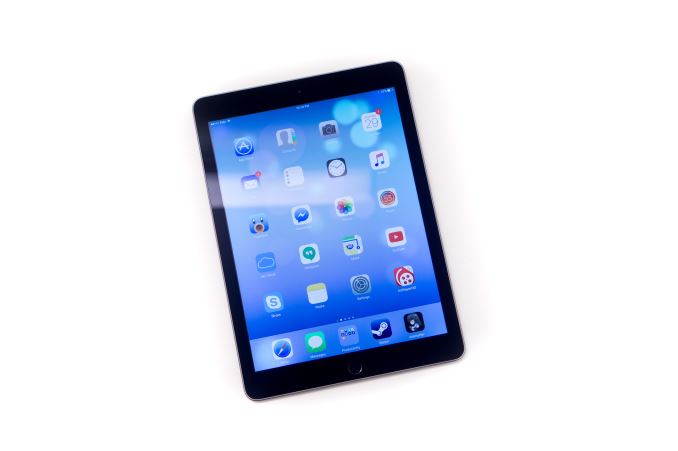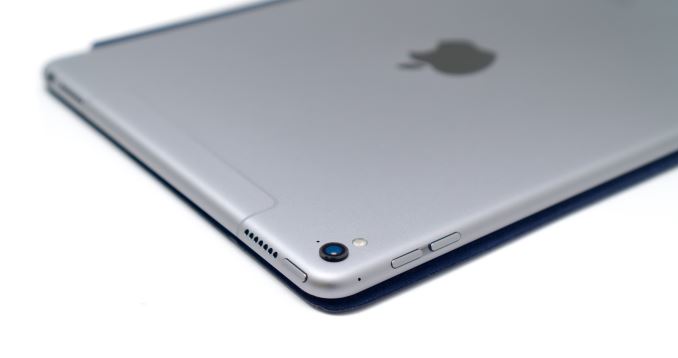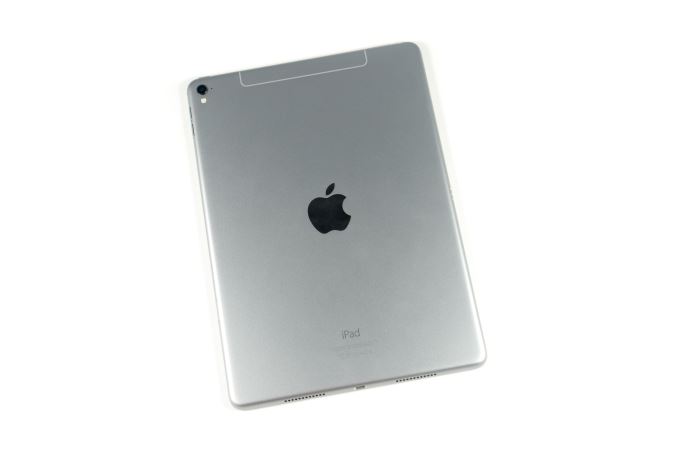The 9.7" iPad Pro Review
by Brandon Chester on June 1, 2016 9:00 AM EST
In late 2015 Apple launched a tablet that they called the iPad Pro. It had been rumored for quite some time, and it had a number of features that differentiated it from other iPads. The most notable was its 12.9" display, which has a width equal to the height of Apple's 9.7" iPads, allowing it to use two essentially full sized iPad applications at the same time in a split screen view. In addition to its massive display, the iPad Pro came with two accessories that had not existed for any prior iPad. It seemed that in Apple's eyes the Apple Pencil and the Smart Keyboard really defined what made the iPad Pro worthy of the "Pro" name.
Meanwhile, the launch of the iPad Pro came and went, and there was no news of a successor to Apple's iPad Air 2, which had just turned one year old. I thought that this move may have had to do with Apple not facing much competition in the tablet market. On the other hand, with iPad sales down it wouldn't generate much excitement to keep selling the same tablet for a second year.
After the launch of the iPad Pro the rumor mill continued to churn out new info, and there were whispers of a so called "iPad Air 3" coming in early 2016. Later, the story became that Apple was actually planning another iPad Pro to take the place of the iPad Air 2 as Apple's flagship 9.7" iPad. In the end it turned out that Apple did exactly that, and along with bringing the specs of the larger iPad Pro to a smaller size, the smaller iPad Pro comes with some surprises of its own. Below you can view the current state of the iPad line now that Apple has two devices called the iPad Pro.
| Apple iPad Family | |||
|
|
Apple iPad Air 2 | Apple iPad Pro 9.7" | Apple iPad Pro 12.9" |
| SoC | Apple A8X 3 x Apple Typhoon @ 1.5GHz |
Apple A9X 2 x Apple Twister @ ~2.2GHz |
Apple A9X 2 x Apple Twister @ ~2.2GHz |
| GPU | PowerVR 8 Cluster Series6XT | PowerVR 12 Cluster Series7XT | |
| RAM | 2GB LPDDR3 | 2GB LPDDR4 | 4GB LPDDR4 |
| NAND | 16/64/128 GB | WiFi: 32 / 128 / 256 GB | |
| WiFi + Cellular: 32 / 128 / 256 GB |
WiFi + Cellular: 128 / 256 GB |
||
| Display | 9.7" 2048x1536 IPS LCD | 12.9" 2732x2048 IPS LCD | |
| Gamut | sRGB | DCI-P3 | sRGB |
| Size and Mass | 240 x 169.5 x 6.1mm 437g WiFi, 444g LTE |
305.7 x 220.6 x 6.9 mm 713g WiFi, 723g LTE |
|
| Camera | 8MP Rear-facing f/2.4, 1.1 micron |
12MP Rear-facing f/2.2, 1.22 micron |
8MP Rear-facing f/2.4, 1.1 micron |
| 1.2MP Front-facing f/2.2 | 5MP Front-facing f/2.2 | 1.2MP Front-facing f/2.2 | |
| Battery | 27.3 Wh | 27.5 Wh | 38.5 Wh |
| Launch OS | iOS 8 | iOS 9 | |
| Cellular | Category 4 LTE + GPS/GNSS in Cellular SKU | ||
| Other Connectivity | 2x2 802.11a/b/g/n/ac + BT 4.2, Apple Lightning, Smart Connector on iPad Pro | ||
| SIM | Optional NanoSIM | ||
| Current Price |
16GB: $399 |
32 GB: $599 128 GB: $749 256 GB: $899 |
32 GB: $799 128 GB: $949 256 GB: $1079 (LTE) |
The 9.7” iPad Pro has the same core industrial design that Apple’s iPads have used since the launch of the iPad Air. The back is almost entirely flat, curving up quickly near the edges and meeting the cover glass with a shiny chamfered edge. Like the 12.9” model, the 9.7” iPad Pro changes things up by moving to a four-speaker audio setup, which requires holes drilled on both the top and bottom of the chassis. Interestingly, the 9.7” iPad Pro uses asymmetrical speaker grilles, with the bottom two being larger than those of the 12.9” model, and the top being smaller. This is likely due to the more constrained space inside the chassis. As for the speakers themselves, the audio quality did seem to be a step down from the larger iPad Pro, but it’s still miles ahead of anything else that I’ve seen on a tablet of this size and a significant improvement from the iPad Air 2.
The 9.7” iPad also comes with some changes of its own. The camera now has a hump, which will undoubtedly upset those who focus heavily on the uniformity of the design. There was no good way to improve upon the iPad Air 2’s camera within a 6.1mm chassis without putting a hump, and as we’ll see later, the camera in this iPad Pro is a huge improvement over Apple’s other iPads. While the hump is there, with such a large chassis the angle it makes with a flat surface is so small that the tablet doesn’t rock back and forth when using it on a table, which is extremely important to ensure the usability of the Apple Pencil.
Apple has also changed up the antenna design. Going back to the first iPads, the cellular models have sported a plastic RF window at the top of the chassis to allow for RF propagation. With the 9.7” iPad Pro, Apple adopts a similar antenna design to that of the iPhone 6 and 6s, where the top now has a metal segment for the antenna with insulating plastic lines surrounding it.
I think this is a significant upgrade to the design of the cellular model for a couple of reasons. Aesthetically it simply looks better, as the plastic inserts weren’t color matched and so they stood out from the rest of the aluminum back cover. They also weren’t always aligned perfectly, and so at the edge between the plastic and the aluminum you could feel a noticeable seam due to the plastic being either at a higher or lower level than the chassis. The new antenna design eliminates both of these issues, and brings the 9.7” iPad Pro as close as it can get to an unbroken aluminum unibody when also having to support cellular networking.
Beyond the changes with the camera, speakers, and antenna on the cellular model, the 9.7” iPad Pro has the same design as the iPad Air 2. They share the same mass and dimensions, and as I mentioned before the core ID is the same. Whether or not Apple could improve upon the design further is up for debate, but they don’t really have any true competition in this space and so they’ve been able to maintain their design lead by making iterative improvements on the original iPad Air design. That design still works very well, and so I don’t see much reason to change things up significantly just for the sake of saying you have a new design.












144 Comments
View All Comments
name99 - Wednesday, June 1, 2016 - link
"The 9.7" iPad Pro does well in 3DMark's graphics test, but like Ice Storm it doesn't do well in the physics test. It seems that this test is programmed in a similar way to Ice Storm, and in that sense I'm not sure how representative the physics test is of real-world performance "The physics test conveys utterly no information. If you look at the code, it's obvious that the physics score basically scales as frequency*numberOfCores. So those octacore CPUs get their one (and only...) chance to shine.
But all you're learning is something you already knew --- that the SoC has lotsa cores running at a high frequency. You're learning nothing predictive about how those cores behave on real code.
An analogy is to judging an SSD by its interface speed --- "ooh, it supports PCIe3x4 --- obviously it must run at 4GB/s under any and all circumstances", or to assuming that the only number you need to know about a memory system is that it connects to DDR4@2400.
name99 - Wednesday, June 1, 2016 - link
I find the NAND performance numbers very interesting when compared to that tiny new Samsung BGA SSD:http://www.anandtech.com/show/10385/samsung-begins...
Sure the Samsung numbers are perhaps 3x higher (given different testing methodologies, etc) but I suspect the Samsung volume and power are SUBSTANTIALLY higher. So Apple is doing remarkably well. It would be interesting to know if they are using tricks like TurboWrite (ie use part of the flash as pseudo-SLC) or if that's still on the table, available for next year's performance boost.
sfwineguy - Thursday, June 2, 2016 - link
Very useful review. Because my own habits may differ from other users, I'm still unsure as to whether I should spring for this new one of try to find an Air 2 (hopefully one with 64 gigs rather than the 16 Apple is offering direct). It seems a bunch of the benefit from the Pro is the camera, which is something I just don't care about.If they had given this the 4 gigs of RAM in the larger Pro, it would be a no brainer for me. I feel like Apple always holds back on the RAM (and tells us we don't need it), which obsoletes their devices quicker than I would like.
ragingfighter - Wednesday, July 13, 2016 - link
In general apple holds back so they get you to upgrade it's a business model it's the way it has to work or you'll be keeping your iPad forever. IN my opinion, I think even if you had a first generation Erewhon is aware the tablet to hold onto. You really have to ask yourself this is it worth spending $600 more not counting the pencil for an additional hundred or the keyboard for an additional 150 that's if you're talking about their base model if you're going be on that then you have to ask yourself if it's worth spending closer to seven to $800. What do you use your tablet for now? Do you find it slow? Have you went to the store and did a side-by-side such a Staples Best Buy or Apple? I would recommend doing that use them a little bit or even go as far as biting the bullet and buy an iPad Pro from Bestbuy demo them side-by-side on the weekend and decide then whether you going to keep it or return it. Depending on where you're from your givien A window of I believe 14 days to return at least a Best Buy it might be an option for you to try them of them both, but your conclusion and stick with itRobertJasiek - Thursday, June 2, 2016 - link
DisplayMate measures "lowest reflectance" but this is the best only for glare displays. Tablets with semi-matte, capacitative touch display must have a much lower reflectance but, unfortunately, so far come with 16:9 or 16:10 display ratios.I wish a Windows tablet with matte, semi-matte or current iPad-like low reflectance display; iPad-like display ratio, casing, weight, battery duration; battery replaceability or service; great WLAN range; BGA SSD; USB and thunderbolt 3. Still the manufacturers of Windows tablets fails to offer displays suitable outdoors with an acceptably low display ratio and a casing suitable for hours of hand holding.
Many iOS apps do not help if the needed functionality is not available; I find it only for Windows or maybe Linux. This and the missing general file management under iOS mean that 2/3 of my tasks incl. productivity (other than simple proofreading) is impossible on iPads. Therefore the iPad Pro 9.7 is too expensive. Its good hardware can never compensate the failure of iOS and apps. This may be different for some needing only mainstream apps and file formats.
adamod - Thursday, June 2, 2016 - link
i would buy it but its waaaay to thick for me...totally unacceptablearsjum - Thursday, June 2, 2016 - link
Is this sarcasm?samer1970 - Thursday, June 2, 2016 - link
the best tablet ? I dont think so , Core M3/5/7 Tablets are better and with full windows 10Hemlocke - Thursday, June 2, 2016 - link
Have you actually used them as tablets? The SP4 is a terrible tablet. It's heavier, it's stuck in landscape, it lacks a lot of touch-optimized apps, it has an inferior screen, and it has inferior battery life.Oh, but Windows, you say. That's great. To get a decent Windows experience laptop out of it, you're spending $1200 for everything, and a $999 Razer Blade Stealth smokes the half-assed laptop that is the SP4, leaving you with $200 to buy an Nvidia Shield Tablet K1, which is still a better tablet experience than the SP4.
nikon133 - Friday, June 3, 2016 - link
Have you used Surface as a tablet, though?I'm using SP3 as my main tablet and laptop. It is stuck in landscape only if you want to use kickstand. If you want to hold it in your hands, it works in portrait just fine. Since I love kickstand, only scenario I use it in portrait is for comics, which I read in app called Cover. Everything else I do in landscape, and even with heavier hardware, being able to use tablet with one hand (while it sits on my lap or on bed, table... at angle I like) while having the other hand free to hold a cup, glass, sandwich... is more than worth extra weight.
I have all the apps I need for tablet mode. Granted I'm not too demanding with apps, but usual stuff - browser, mail client, FB, maps, weather, FB messenger and Skype, YouTube player, News client, comics and ebook readers, music and media players... are all there and perform well under touch.
I can get 8 hours of light usage out of fully charged Surface Pro 3. Most common scenario, browsing, will fluctuate wildly, but hit usually comes with Flash-heavy sites. Not sure if I can open them on iPad at all. And then, there's very nice type cover sitting in vicinity - if at any moment I decide that whatever casual I do will require some serious typing, transformation is 1 second away.
As a laptop - surprisingly enough, SP4 released keyboard (which works with SP3, too) is one of finest laptop keyboards I have ever used, and even touchpad is quite good - maybe not on MB level, but as good as any Windows laptops does... and I still get to use touch screen, which I do. I wouldn't like touch screen on my desktop's screen, but on small screen that usually sits closer to me than desktop, it makes a lot of sense.
My SP3 also has full Office, Photoshop, Lightroom... among few other desktop programs. I'm using desktop for really heavy lifting at home - and gaming - and SP3 replaces laptop and tablet very nicely for me, at home and on travels. iPads are nice - I'm buying them for my mother every 2 years or so - but they just can't replace both laptop and tablet for me, and since I live in NZ - almost every trip is intercontinental, and having one device less to drag is easily noticeable.